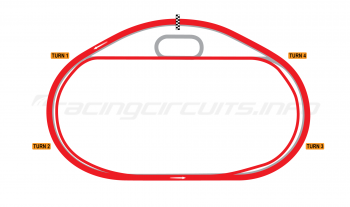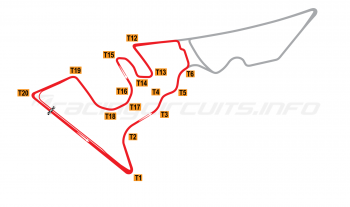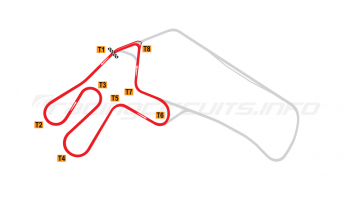El Zonda
Circuit Overview
The Autódromo El Zonda can certainly boast one of the more spectacular locations in world motorsport, being set within the Quebrada de Zonda ravine, just outside the city of San Juan.
Hemmed in on all sides by rocky outcrops, the track is a natural amphitheatre with spectators clinging to the hillsides for a view of the entire course. The restricted size of the parcel of land led to the track requiring a figure-of-eight cross-over design to meet minimum length requirements.
It is now formally named the Autódromo Eduardo Copello in honour of “El Maestro”, who was the winner of the inaugural race at what was his home track. More recently the track has been a regular host of the ever-popular TC2000 Championship and Top Race V6, alongside regional and local races.
Circuit History
Motor racing has a long history in San Juan, with street races organised at a variety of locations before settling on the Parque de Mayo. An accident at the venue in 1966 led to a ban on street racing being put in place across San Juan province.
This left the race’s organising body, the Asociación Sanjuanina de Volantes (ASV), scrambling to find an alternative venue for the following year’s racing. An appeal by the President of the ASV, Antonio Meritello Lampazon, to the San Juan Governor for assistance to build a permanent racing circuit was however received positively. In tun the the Minister of Public Works, engineer Hugo José Montes Romaní, was instructed to find a suitable location and build a track.
It just so happened that Montes Romaní was a motorsport enthusiast, who as a child had dreamed of having a proper racing circuit in San Juan. Impractical and costly as it seemed, his vision was for a circuit inside the Quebrada de Zonda, a deep and narrow ravine in the Marquesado mountain ranges, on the western edge of the city. An arid plateau, hidden among the mountains, it was mainly scrubland and a place to shelter from the sun, wind and birds. But Montes Romaní could see the potential, with the hillsides affording spectators a natural amphitheatre from which the whole track would be seen.

In an act of administrative decisiveness he had little hesitation in declaring: “The racetrack is going to be here. You have to beat the hill and that’s it.” The childhood imaginings were, however improbably, about to be made a reality.
The challenge of fashioning a road racing circuit in the rock outcrop was thus turned over to the provincial highways department, headed by engineer Miguel Yolando Carmona. The department’s engineers Romano Petrini and Alberto Olivera were entrusted with designing and building the facility, so visits to various other racetracks and studies of plans of the Nürburgring and Monza circuits formed part of their initial research.
The engineers soon realised that their allocated plot of land was actually quite small if a course of at least three kilometres was to be built, as was the norm for international racing. As well as the narrow ravine limiting the track’s width, at the eastern end lay the ornamental park of the Jardín de los Poetas (Poet’s Garden), which was a popular local attraction. Bulldozing that completely to make way for the circuit was considered but was always likely to attract considerable local opposition, so another approach was needed.
The solution lay in a figure-of-eight layout, with a crossover bridge added allowing the track to squeeze in just enough additional asphalt to top the magic 3km mark. The resulting series of lightly banked corners which formed the eastern end of the circuit came to be known as ‘The Curler’. Construction began in 1966 and ran through into 1967, albeit not in time for the traditional July date for the Turismo Carretera race, which was held instead at the nearby Las Chacritas airfield. This provided a stop-gap replacement until the new course was ready.
Circuit proves a hit, draws a champion’s praise
With work complete, it was with great anticipation that the inaugural event was scheduled for October 8, 1967. The ‘Lotería Gauchita de San Juan’ was a race for Turismo Carretera machinery, featuring twin 10 lap heat races on Saturday and 20 lap grand final on the Sunday.
The publicity for the new circuit drew a large crowd for what was the largest sporting event held in San Juan at that time. Among the illustrious visitors to the new circuit were five-time Formula 1 World Champion, Juan Manuel Fangio, and Oscar Alfredo Gálvez, himself another five-time champion, this time in Turismo Carretera.
On seeing the new course, Fangio was effusive in his praise, declaring: “It’s the best racetrack I saw in my life!” He evidently meant it and was not just saying what the Sanjuaninas wanted hear: he went on to hire engineers Petrini and Olivera to design him a similar circuit for his home town of Balcarce.

Home town hero proves hard to beat
The race itself featured a number of the big stars of the Turismo Carretera series, including the works IKA Torinos Team that swept all before it that year. Home town hero Eduardo Copello was joined by Héctor Luis Gradassi. and Jorge Juan Ternengo. For this event, Copello’s car was fitted with an experimental aerodynamic nose designed by Heriberto Pronello, which gained it an additional 5 kmph along the circuit’s long straights.
Saturday’s heat races were held in sweltering heat. With his ‘unfair advantage’, Copello proved unbeatable in the first 10-lapper, taking the lead on the second lap and heading home his team mates, with Gradassi in second and Ternengo in third.
The second heat saw Carmelo Galbata in a Ford Falcon F100 taking the chequered flag in first, with Carlos Oreste Marincovich in a Bergantín finishing second. The high temperature caused the new racing surface to break up, with the asphalt needing various repairs to be carried out overnight.
A field of 17 cars set off for the Grand Final on Sunday. When race starter Fangio dropped the flag, Carlos Marincovich shot into the lead but was soon passed by Copello on the second lap. The pair swopped positions once more, with Marincovich pulling away on the start/finish straight, only for Copello to reel him in on the backstretch. The crowd was treated to an entertaining scrap between the two leaders for several laps before Copello took the lead and pulled away to victory.
After the race Marincovich revealed he had slowed deliberately to conserve his car, concerned as he was about the state of the track which had again begun to break up. The flying asphalt had broken his windscreen on lap 16, leading to him dropping to third when the Torino of Gradassi passed him. He reclaimed the position when Gradassi’s tyre exploded and sent him to the pits.
By the end of the race, the cars were having to slow to a snail’s pace at the final hairpin and the state of the track saw several more broken screens and a number of spins. Not that Copello cared as he took the chequered flag in front of his home crowd to score a memorable win.
“This is the happiest win of my life,” ‘El Maestro’ said afterwards. “It’s wonderful. This debut with a victory at the inauguration of the racetrack in my home town will be engraved forever in my memory.”
Turismo Carretera returned to the racetrack in 1968, Copello swept to an even more dominant victory over two heats, finishing the overall classification a lap ahead of his nearest rival, Gaston Perkins in an older Torino. The race wasn’t without its drama for the leader, after gear linkage problems left him stuck in third gear for the final seven laps.
That, however, proved the final visit for the Turismo Carretera drivers; despite the success and popularity of the events, the track was dropped from the schedules in 1969 and never returned.
International stars arrive with F2 Temporada
El Zonda garnered some worldwide attention in 1968, when it hosted the final of the three-race Temporada Series for Formula 2 machinery. The aim was to highlight Argentina as a potential host for the cars of Formula One, which would ultimately prove successful at the refurbished Buenos Aires circuit. The stars of European Formula 2 - many of whom were also on the F1 grid - would prove a good appetiser.
In preparation, the track installed 21 new pit boxes, which boasted working showers for the teams and drivers - something of a novelty in those times. A booth for radio broadcasts was also constructed, in anticipation of the additional media interest the race would generate.
The starting lineup, while not massive, nevertheless boasted a star line up. Headline act was undoubtedly the works Ferrari team, which entered a pair of Ferrari Dino 166 cars for Andrea de Adamich and Tino Brambilla. Matra also had its works cars for Henri Pescarolo and Jean-Pierre Beltoise. Frank Williams entered a trio of Brabham BT23C-Fords for Piers Courage and local drivers Carlos Pairetti and Juan Manuel Bordeu. Other notables in the field were Clay Regazzoni, Pedro Rodriguez , Jochen Rindt and Carlos Reutemann.
The weather threw in a few curveballs. When it wasn’t swelteringly hot, the winds whipped through the ravine to create dust clouds so thick that many resorted to breathing through handkerchiefs. So bad was the wind on Saturday that qualifying had to be abandoned, with the grid set by Friday’s practice times: Drivers spent much of the day holed up in the Hotel Nogaró (now the Hotel Provincial) attempting to cool down in the pool.
It was bad news for Jochen Rindt who hadn’t run on Friday and thus was forced to start at the rear of the 21-car grid. The forceful Austrian persuaded the organisers to let him get a few practice laps in nevertheless.
Race day dawned with the heat failing to let up, as thermometers hit thermometers topped 43 degrees centigrade. Jo Siffert started from pole in a Tecno TF68-Ford with a time of 1m09.9s.
The race was scheduled for 70 laps, which would prove punishing on car and machinery alike in the heat. Carlo Reutemann’s Brabham did little to cool proceedings, electing to catch fire on lap two, fortunately without injury. Second place qualifier Andrea de Adamich blasted off into a dominant lead which he would never relinquish, followed home some 18 seconds later by the Matra of Beltoise. Jochen Rindt round off the podium, having made a magnificent charge from the rear of the grid. Top Argentine was Eduardo Copello, two laps down in eight place. Juan Manuel Fangio again waved the finishing flag on what was something of a one-off international event.
Circuit establishes itself on the national calendar
By 1970, the circuit had a new headline event, with the debut of the Formula 1 Mecánica Argentina. Emilio Bertolini took victory for the locally-made single seaters but the race was marred by tragedy, when driver Raul Kissling crashed and was thrown from his car. While he suffered only minor injuries, an errant wheel struck a pole, which collapsed and killed a child in the crowd. It was the first recorded fatality at the circuit.
Formula 1 Mecánica Argentina visited just once more in 1977 before the circuit found its real niche with touring car racing. Turismo Nacional was a regular visitor into the 1980s before becoming more sporadic into the 1990s, but TC2000 has been a regular visitor from 1981 to relatively recent times, with its last race in 2019. It also hosted Top Race V6 from 2004–2011, and then 2016–2019.
The circuit has received one layout modification in its lifetime, when a new, tighter Turn 5 and 6 complex was added, breaking the flow somewhat but reducing speeds through Turn 7 under the crossover bridge parapet. The original layout remains in place but is seldom used for competition.
Jump onboard
Circuit info
- Autodrome Eduardo Copello “El Zonda", San Juan, Argentina
- +54 264 540-0000
- Email the circuit
- Official website
Rate This Circuit
Votes: 1941
Plan a visit
Get your race tickets!
Brought to you with: 
We've teamed up with Motorsports Tickets to bring you the best deals for Formula One, MotoGP, Le Mans and more.












